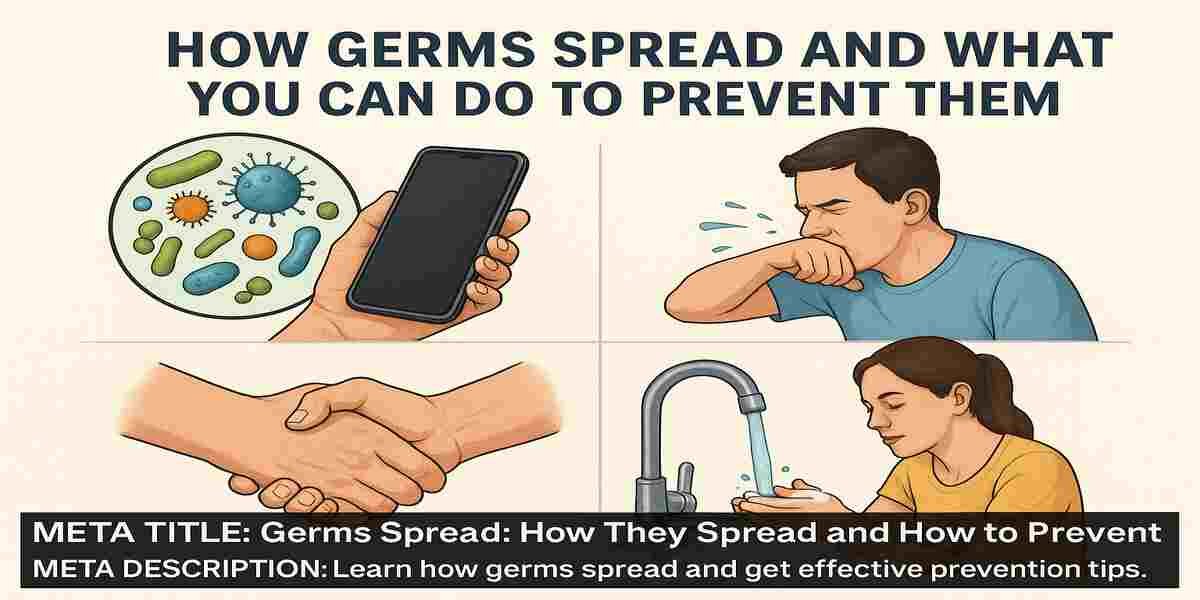How Germs Spread and What You Can Do to Prevent Them?

How Germs Spread and Simple Ways to Stop Them
Have you ever wondered how many more germs that phone of yours is harbouring at this time? Or the possibility of rubbing your face and a doorknob and letting hostile bacteria enter your body? We usually just ignore the unseen world of germs, but daily, they contribute a lot to our health. All the good news is that you have a chance to defend yourself and your family with some knowledge and a few new, simple habits against their adverse impact.
This blog gets into the usual germ culprits, their transmission, and best of all, prevention. You will end up feeling empowered because you will have some real strategies to keep your environment cleaner and safer.
1. What Are Germs?
Germs are those microscopic creatures that are present everywhere around us, in our hands, in the air, on all household surfaces and also in our bodies, as per Bond Cleaning Southport. They cannot be seen using the naked eye, yet they influence our health in a massive way. There are four major categories of germs, namely bacteria, viruses, fungi and protozoa.
Bacteria are microscopic living organisms. But there are also healthy bacteria, e.g. those that aid in digestion, but at the same time, there are bad bacteria that cause an infection, e.g. Salmonella or Staphylococcus. Viruses are minute and require a living host to live. They multiply themselves in your organism and cause diseases like the flu or COVID-19. Fungus also consists of moulds and yeasts, some of which may cause skin-related problems such as athlete’s foot or even life-threatening respiratory infections. Protozoa, which are present in dirty water, may predispose to gastrointestinal problems
2. Where The Germs Hide in Your Life
Parasites flourish in unexpected places. These most germ-ridden objects are found within our houses, although we may expect the above-mentioned sources most often in public places as well as in the restrooms. Hot zones of bacteria and viruses are objects that are in constant contact with hands and are not wiped away frequently.
Such contact points are light switches, door knobs, remote controls, mobile phones and kitchen sponges. Even sinks and cutting boards may be the carriers of more germs than a toilet seat. Since these are some of the invisible areas,, you must learn to identify them and clean them up regularly in order to lessen your chances of becoming infected.
3. How The Germs Spread With Ease
Germs are fast and easy to spread using some of the common means. The most widespread transmission is the direct one, with shaking hands or touching some contaminated items. After being on your hands, germs will find their way into the body through the touch of your eyes, nose or mouth.
Airborne droplets can also cause their transmission whenever a person sneezes or coughs. For official details on how communicable diseases spread and how to reduce risks, visit the Australian Government’s About communicable diseases page.Indirect transmission: In this type of transmission, indirect contact is made with the personal things of people, such as towels, makeup devices, or utensils. Food and water with impurities also play a significant role, and this is particularly in those times when cleanliness during the preparation or storage of food is not observed.
4. Easy-to-Follow Habits to Break the Chain of Infection
Prevention of germ spreading does not require high technologies but only wise, conscientious practice. The best defence mechanism is handwashing. Before eating, after using the toilet, and after coughing and sneezing, you must wash your hands with soap and water for at least 20 seconds. Without soap and water, plain usage of alcohol-based hand sanitiser can assist.
One should also clean the surfaces periodically. Clean phones, doorknobs, keyboards and countertops using EPA-approved cleaning compounds. Even the natural ones, like vinegar and tea tree oil, can take effect, as long as one knows how to apply them. Proper etiquette of coughing and sneezing is also useful. Hit a tissue or your elbow, and dispose of tissues at once, and then wash your hands. There is also no need to put your hands on your face since it lowers the risk of bringing the germs into your body.
5. Make your home germ-free
Being a clean person in his /her house also reduces germ transmission to a large extent. Pay attention to the places that can be most easily contaminated. As the laundry area is concerned, launder towels, bed sheets, and reusable masks regularly. Where this is possible, use hot water and make certain they are thoroughly dry. This assists in killing the bacteria and fungi which may be residing on wet fabric.
Wash all the surfaces and other kitchen cleaning essentials, and particularly raw meat. The use of disinfectants in the cleaning of cutting boards should be instituted, and sponges should be regularly changed to prevent bacterial accumulation. Another area that must be concentrated on may be the bathroom-wash the toilets, faucets, and toothbrush holders regularly. Ensure that you always close the flush before flushing to avert the spread of germs in the form of droplets.
6. Build Up Your Defence System
A well-performing immune system is the primary response against the onslaught of germs. Your lifestyle plays a very vital role in terms of whether or not you respond well or badly to infection in the body. Start with healthy food with a lot of fruits, vegetables, whole grains, and protein. Such foods ensure that your body acquires the second nutrients, which are needed for the functioning of your body, such as vitamins and minerals. The use of a lot of water is not bad when it comes to washing off toxins and lubricating the system.
Sleeping between 7-8 hours nightly allows the body to heal and fix itself. The physical exercises appropriate promotion of blood flow and immunity, and control the stress level will guarantee that the body’s defence system remains effective. The initial weapon of defence against dangerous germs is a healthy body.
Conclusion
The germs are invisible to the naked eye, but they still have an impact. Being aware of what they are, their hiding places, and their spread enables you to make choices on your environment. With multiple daily routines, like using soap to clean your hands, bleach to clean the surfaces, and reinforcing the first line of your defence mechanism, you will be able to reduce your own susceptibility by a great percentage and protect your neighbours.



